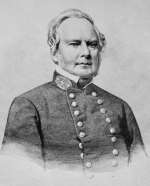Search:
Powered by
Website Baker
Tour Stop, “Price's Wagon Train”
[Waypoint = 39.019064, -94.520287]
Directions
This tour stop is located just about 100 feet up the Historic Byram’s Ford Road. It’s a change in elevation of about 20 feet. From the east side of Hardesty, walk up the Historic Byram’s Ford Road. Continue walking up the road until you come to the place where the road narrows because of two large outcroppings of limestone. Stop after you get past this spot on the road. Look for one of those temporary signs attached to thin, orange fiberglass poles, about three feet tall.
Description
 Sterling Price courtesy of the Library of Congress |
When Major General Sterling Price entered Missouri on September 19, 1864, his train included around 300 wagons, most of them empty. One of his objectives was to capture as much of the Federal’s war-making supplies as possible. By the time Price reached western Missouri, he had between 500 and 600 wagons loaded with plunder. The Confederates were also trying to bring along a herd of some 3,000 cattle. By the time he reached Independence, Price was concerned with getting his wagon train loaded with plunder safely away to Arkansas. He planned to leave the area through the eastern part of Kansas continuing his work of plunder and destruction. His immediate objective was the border town of New Santa Fe.
You are standing on the same road on which the wagons travelled in 1864. A team of four to six mules hauled each wagon down the road through numerous these limestone outcroppings. This was not the main road from Independence across the Big Blue River. Byram’s Ford was not the best ford available to cross the Big Blue River. It’s unlikely the road was much better condition than it is today.
Major General Sterling Price chose this route because of the tactical situation facing him on October 22, 1864. On the surface, it seems the simplest route would have been to continue down the Santa Fe Trail, cross the Big Blue River at the Red Bridge and then on to New Santa Fe. When his wagon train was on the move, it stretched out for over five miles. Price knew this would make an easy target for the Federal cavalry under Major General Alfred Pleasonton. Likewise, going down river over the crossing on the Main Independence to Kansas City Road would leave his wagon train exposed to the Federal cavalry under Major General Samuel R. Curtis.
So Price decided to split the difference and use the Byram’s Ford crossing. He would put the Big Blue River between his wagon trains and Pleasonton’s cavalry. His wagon train would be exposed to Curtis’ cavalry for a relatively short distance. In addition, while exposed on the east side of the river, Price would have the advantage of being able to defend interior lines. So Byram’s Ford turned out to be the best of a bad lot.
As you walk up the hill to the next tour stop, remember the Confederate wagons passing over this same road on October 22, 1864.
Historical Vignettes
As you walk on this section of the Historic Byram’s Ford Road, you can get a sense of the difficulty in moving such a large wagon train from Independence to New Santa Fe descried by Howard N. Monnett in his book, Action Before Westport 1864.
"During the night the movement of the wagons and herd had been particularly difficult. The road went up one hill and down another and in the darkness the files stretched and came together again, accordion fashion, until the officers swore at the continual halts, succeeded by bone-jarring trots to keep up as the leading units stretched their pace on the downhill stretches."
Union Brigadier General John B. Sanborn described the situation faced by Major General Sterling Price with his huge wagon train.
"During his progress through the state General Price had secured by almost universal and indiscriminate impressments a long train of several hundred wagons, chiefly common farm-wagons of good quality, into which had been loaded the spoil of the campaign —clothing, provisions, forage, the contents of drug-stores, etc. He had also collected from the country large herds of cattle and flocks of sheep, which were being driven along. Realizing now that he was in a “fix," Price [was now] passing his train and supplies to the southward, sought to escape into Arkansas with the plunder he had secured. "
Major John C. Moore began the campaign into Missouri as Senior Assistant Adjutant-General in the brigade commanded by Brigadier General John B. Clark, Jr. Moore described how, after their defeat near Westport, the wagon train greatly inhibited the Confederate army’s ability to retreat to safety.
"Battered and bruised, and with its ranks decimated, the army emerged from the trap in which it had been caught with a feeling of personal hostility on the part of the men to the enormous and useless wagon train which had been the principal cause of their discomfiture and losses, but with the idea that now they had started southward in retreat and had the enemy behind them, the column would be stripped of all superfluities and encumbrances and would move forty or fifty miles a day. With them retreat meant hard, rapid marching, at least until they got rid of the heavy masses of the enemy. Their horses were in better condition than those of the enemy, and they knew that in two days' time they could leave any pursuing force capable of seriously interfering with them far behind."